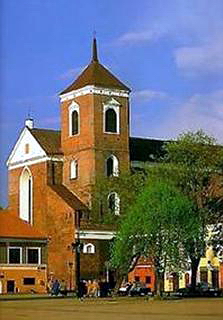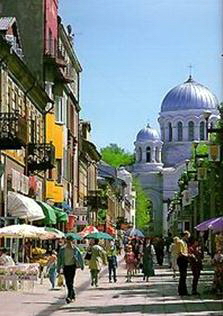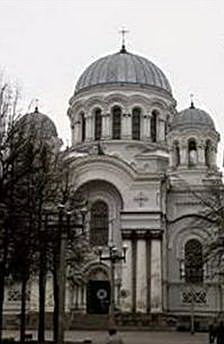|
|
| HISTORY
Kaunas is situated in the valley of two longest rivers of Lithuania, the Nemunas and the Neris, and was first mentioned in 1361. Until the beginning of the 15th century, Kaunas Old Castle was important resistance post against the attack of the Teotonic Order. After victory of Joint Lithuanian - Polish forces in the Zalgiris (Grunwald) battle in 1410, during the reign of Vytautas the Great, the Grand Duke of Lithuania (1392 - 1430), the period of the true properity started. At that time Lithuania had already accepted Christianity. Kaunas was given the Magdeburg rights and enjoyed the years of development in trade, crafts, culture, and extensive contacts with Western Europe. In stroll around Old Town one may encounter numerous fragments of late Gothics. The city symbol of the white Town Hall is mainly Baroque, possessing trends of the Gothics, Renaissance and Classicism. |  | | As Kaunas itself, accumulated the best features of Gold Ages. The World War I stopped the further development of Kaunas. There was a war state. Vilnius was occupied by Russians in 1919, so State Council, Ministers Cabinet, and other offices were settled in Kaunas. In 1920 Poland broke Suwalki Treaty and occupied Vilnius. Kaunas became the temporary capital and the main city of the country. During the independence years Kaunas grew, the population increased. The buildings were being reconstructed, a lot of new ones were built. The buses started to run in 1924 and the urban water supply was constructed in 1928. But this short period was stopped by brutal Soviet occupation. The economics and culture suffered. After World War II rebuilding was started. Hydroelectric power station started to work in 1959. Only since 1988 with the movement of freedom the reviving works started. The old streets, squares, War museum orchard regained its former look with the monuments from independence times. |  | THE OLD TOWN
Kaunas enjoys a remarkable Old Town which is a concentration of ancient architectural monuments: the remnants of the 13th century Castle, the Cathedral, the Jesuit and ST. Trinity Churches as well as the Old Town Hall, nicknamed the "White Swan" for its charming architecture. The Old Town Hall Square, the most important architectural accent of the Old Town, is reminiscent of the Middle Ages with the early Gothic Vytautas Church and the late Gothic Perkunas House not far away. The Old Town squares and buildings of the surrounding streets are brisk with numerous restaurants, bars and cafes as well as art galleries and Lithuanian folk art souvenir shops, popular among tourists. | | KAUNAS CASTLE
Kaunas' castle is a beautiful fortune in the middle of the city. It is known that even in IV-V centuries there were medieval buildings, which may be precursors to later castle. Kaunas castle was built by German architectures and it is known as the oldest brick castle in Lithuania. It is located in the crossing between two largest Lithuanian rivers – Nemunas and Neris. Because of strategical location, it was the most important point in fights with Crusaders. Many legends and poems are directed to Kaunas' castle. Few year ago Kaunas' castle was renovated with the maintenance of authenticity. Nowadays it is a popular museum, around which many events are organized. In summer many people come to walk the park, located next to Kaunas' castle and spend the time with ancient speck located in the city center. |  |  | TOWN HALL SQUARE
The ancient heart of Kaunas is the Town Hall Square surrounded by a number of 16th century German merchants houses. In its centre towers the 53-metre high white Town Hall, late baroque in style, with elements of early classicism and gothic architecture, The construction started in 1542 and it was supposedly built as a one-storey building. The second floor and the tower were added at the end of the 16th century. The cellar of the tower served as a prison and a warehouse. The ground floor was reserved for traders and the prison guards. The first floor housed the magistrate, the treasury and the archives. Partly destroyed during the Swedish-Russian war (1655 - 1660) it housed the municipality after reconstruction in 1771. Under the tsarist regime it was transformed into an orthodox church and it even served as the provisional residence of the Tsar in 1837. | | CATHEDRAL
The first church was supposedly built in the early 15th century. The naves were built in the 16th century and construction lasted until in 1775 in baroque style. Interesting neogothic chapel. In 1895 the church became a cathedral and was elevated to the rank of basilica in 1921. Tower 41,9 meters high. In one of the walls the bishop and writer Motiejus Valancius is buried. |  |  | LAISVES ALEJA (LIBERTY AVENUE)
Laisves Aleja is the main business area of Kaunas with offices, shops, restaurants, and banks. Kaunas residents love to stroll down the 1,621 kilometre long street, designed in the late 19th century which leads to St. Peter and Paul's church. In 1982 it was closed for traffic and the central tree-lined pathway was dotted with numerous benches. Reposing and green in the summer, it can be quite grey and depressing in the winter. | | MICHAEL THE ARCHANGEL
The blue imposing catholic church is commonly called "soboras", since it has all the aspects of an orthodox church. Transformed into an art gallery during the Soviet period, it was recently reopened to public wor-ship although the interior is still unfinished. Built in 1891-93 by Russian architects, the neo-byzantic style symmetrical building at the end of Laisves aleja was originally destined for the army of the Kaunas castle. |  |  | PAZAISLIS CAMALDOLESE MONASTERY
The ensemble of building created in XVII century is a unique pearl in Kaunas city. The visit to this place is always pleasant not only because of magnificent architecture and past breeze, but also because of the possibility to walk the Kauno Marios coast. This place should be interesting for those, who find themselves as history lovers. Pazaislis Camaldolese Monastery went through many difficult times and survived war, fire and various devastations. Kaunas Marios regional park, which surrounds the architectural complex, is also touched by interesting stories, since many people had to leave their houses and give their places to Kaunas Marios dam. Many old houses are still standing underneath the water… | | KAUNAS 9th FORT
Lithuanian history is full of sad times, when war ruled our country. When some people try to forget painful moments, buildings, that were build on military purposes, keep silent history in their walls. However, a sensitive touch to history helps to raise the respectful view to every person, who end up as a war victim. Kaunas 9th fort is a relic of XIX century early ages, when Lithuania was a part of Russian imperia. However, the main and the most painful history of Kaunas 9th fort is related to World War II, when it was used as innocent people killing place. Terrible, although – very interesting, stories are protected between 1.5-2 meters width walls. Nostalgic and sad feeling overtake every visitor, however it also gives the opportunity to overthink the past historical mistakes and realize the importance of humanity and peace. |  |  | PARKS
Kaunas city is not only urban place – we have some natural places, where you can escape from the city bustle. The Oak Wood is in the heart of the city, on the top of Panorama hill. This is the biggest oak wood located in the middle of a city in whole Europe. We can be proud of 63 ha territory containing specific rest zones for local people and visitors. You can find many important historical sculptures while walking the soothing way through the park. | | MUSEUMS
Lithuanian medicine and pharmacy museum
Every person, who is related to medical science should visit this museum. The visit to this museum gives the opportunity to time-travel. Interesting stories leads old instruments and documents that add interesting information to knowledge baggage. Museum's exposure contains original papers, materials and instruments that were used by real people. Furthermore, the museum is located in old pharmacy, where you can feel ancient times spirit. Medicine and pharmacy museum is supported by Lithuanian University of Health Sciences and is located in the middle of town hall.
T.Ivanauskas zoology museum
Kaunas Tadas Ivanauskas's zoology museum is one of the oldest museums in Lithuania. This is the only zoology museum in Baltic contries. Tadas Ivanauskas is a memorial person to Lithuania, he was prominent person in nature sciences. The museum exhibition gives the opportunity to travel whole world in one building. All exhibits are composed in as natural way as possible with the illusion of moving animals in their natural places. Only three years left until the huge anniversary of Kaunas zoology museum – it was established in 1919.
Art museum
Mikalojus Konstantinas Ciurlionis is a famous Lithuanian composer and artist, who lived in XI-XX century. In early ages M.K.Ciurlionis was noticed by world class musician M.Oginski, who funded M.K.Ciurlionis studies in Poland. Most of this popular artist's paintings can be viewed in Kaunas. The most impressive painting – "Rex" can also be observed in Kaunas M.K.Ciurlionis art gallery. |  |  |
|

